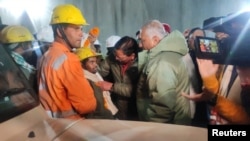Forty-one construction workers trapped in a North India road tunnel in the Himalayan mountains for 17 days were evacuated Tuesday after a mammoth rescue operation.
Crowds cheered, and sweets were distributed, while some locals offered prayers at a makeshift temple that had been built near the tunnel. The workers — who crawled out of the tunnel — were garlanded, greeted by top state officials and later taken to a hospital for a medical check-up.
Chief Minister Pushkar Singh Dhami of Uttarakhand state said the men were all healthy.
The tunnel caved in on November 12 during work on a $1.5 billion highway project in Uttarakhand. Initial hopes that the men would be rescued within days faded as the operation encountered repeated setbacks in the challenging Himalayan terrain.
The crucial breakthrough was achieved by a group of workers known as “rat-miners,” who used handheld tools late Monday to remove the rock and debris blocking the last section of the 60-meter rescue passage being drilled through the mountain to the tunnel.
The rat-miners were brought in after the high-powered machinery being used broke down last Friday.
“The rat-miners worked in an enclosed space. They dug through 10 meters in less than 24 hours. This is almost as if a machine has been working. They really need a salute from our side,” Syed Ata Hasnain, a member of the National Disaster Management Authority, said at a press conference.
The rat-miners also drew praise on social media, with some people calling them “unsung heroes.”
The rat-mining technique, used in coal mines to dig narrow pits, was banned in 2014 because it was considered hazardous. Officials, however, told reporters that the rat-miners' skills could be used in “life-saving” situations.
“It was a difficult task, but for us, nothing is difficult," Firoz Qureshi, one of the rat-miners, told reporters.
Prime Minister Narendra Modi called the success of the rescue operation “an emotional moment for everyone.”
“To the workers who were trapped, I want to say that your courage and patience is inspiring. I wish you good health and well being,” he posted on X.
Relatives of the laborers had been camping at the site for days and expressed happiness that their family members were safe. The construction workers were mostly migrant laborers from some of India’s poorest states.
Multiple teams from different Indian agencies, international tunneling experts and army engineers were involved in the marathon mission.
“We met many hurdles, and we had to keep remaking plans,” Hasnain said.
Nitin Gadkari, India’s minister of road transport, called the rescue operation “a well-coordinated effort by multiple agencies, marking one of the most significant rescue operations in recent years.”
Contact was maintained with the trapped men with a camera inserted through a 15-centimeter pipe that was inserted into the tunnel.
Authorities have not said what caused the partial collapse of the tunnel, part of an ambitious road project to improve access to important Hindu pilgrimage sites in Uttarakhand. Reports say a landslide caused the accident.
The government said it will conduct a safety audit of more than two dozen tunnels being built as part of road projects across the country. Most of them are in Himalayan states, where the cave-in has raised questions about the construction spree in the fragile, mountain region. Questions have also been asked about why the tunnel did not have an emergency exit route.
Several experts have also opposed the 900-kilometer Char Dham Highway project, saying that blasting hillsides and felling trees would disturb the geology of the Himalayas, the world’s youngest mountain chain, as well as pose a risk to communities living in the vicinity.







